“I realized early on that I wanted to make a brand new mark, because I don’t come from art history. I landed there."
McArthur Binion -
Gray is pleased to present the gallery’s first solo exhibition with McArthur Binion, and his first in Chicago since 2016. Debuting eight paintings and seven drawings from the artist’s DNA:Work and Under:Conscious Drawings series, the exhibition is open at Gray Warehouse for in-person or virtual viewings by appointment.
THE DNA:WORK PAINTINGS
As an index of time, labor, and identity, Binion's iconic DNA:Work paintings repurpose the Minimalist grid to examine a deeply personal narrative. Using the scale of his own body, Binion builds compositions from vivid, geometric patterns demarcated by an oil-stick grid. Up close, each painting reveals a substrate of tightly collaged and rhythmically arranged reproductions of personal documents, including pages from the artist’s phone book, his birth certificate, and photographs of his childhood home in Macon, Mississippi. Binion’s pared-down combination of color and form compresses a breadth of influences—personal history, relationships, writing, and memory—all absorbed throughout a life dedicated to making. As art critic and poet John Yau describes, Binion’s DNA paintings are “deeper than autobiography… [his] formal mastery, his ability to wring so many possibilities out of his direct and straightforward labor, permeates the works with layers of meaning, beginning with his challenge to the idea that art could be objective and pure, that it could exist in a separate aesthetic realm untainted by life.”[i]
IN DIALOGUE WITH MCARTHUR BINION
On the occasion of his exhibition at Gray, McArthur Binion joined artist Torkwase Dyson for a conversation at his studio in Chicago. In their recorded discussion, the two artists examine the fragments of personal history Binion layers into each of his paintings as well as Binion's art historical predecessors and peers. The full conversation is available to read here, or in the accompanying exhibition catalogue. Below is an excerpt from this dialogue.
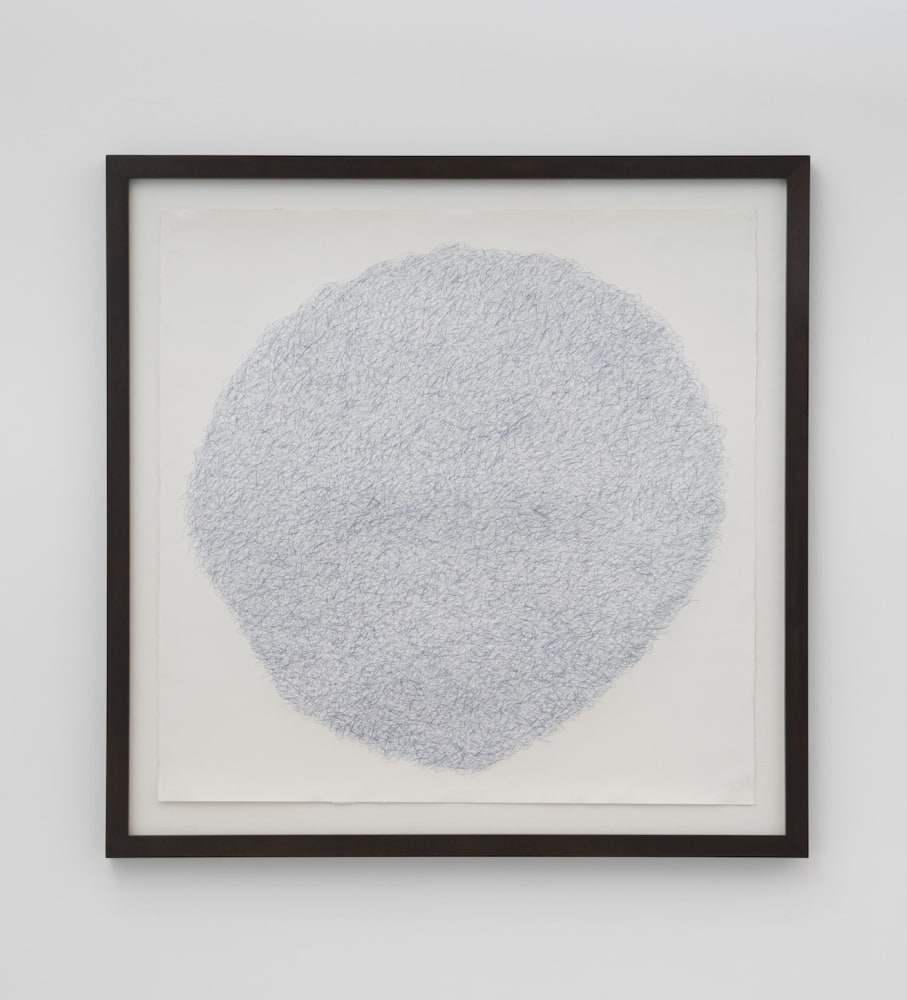
Torkwase Dyson: Working with the 'under-conscious' started with the drawings?
McArthur Binion: I was dealing with the idea of the under-conscious already, but the drawings came from a need to try to make language for it. I never had much language for it. But what was clear to me was that everything always started with the under-conscious. I explain it like this: I’m not discovering the under-conscious, I’m becoming it. It’s the character just under the surface, close to the skin. It comes from a raw intellect, a raw instinct, not an educated intellect. It’s the stuff you don’t have to think about. It’s the thread that nails the work. And I really never intended to work with the under-conscious this long but the idea resonated so much with me, I stayed close to it.
TD: You created all of these lines, these fissures, these marks, all over, over and over, one up against another, all by hand?
MB: Yeah, I use my left and right hands. That’s where the drawings come from, that’s where the under-conscious comes from—the buildup of my marks.
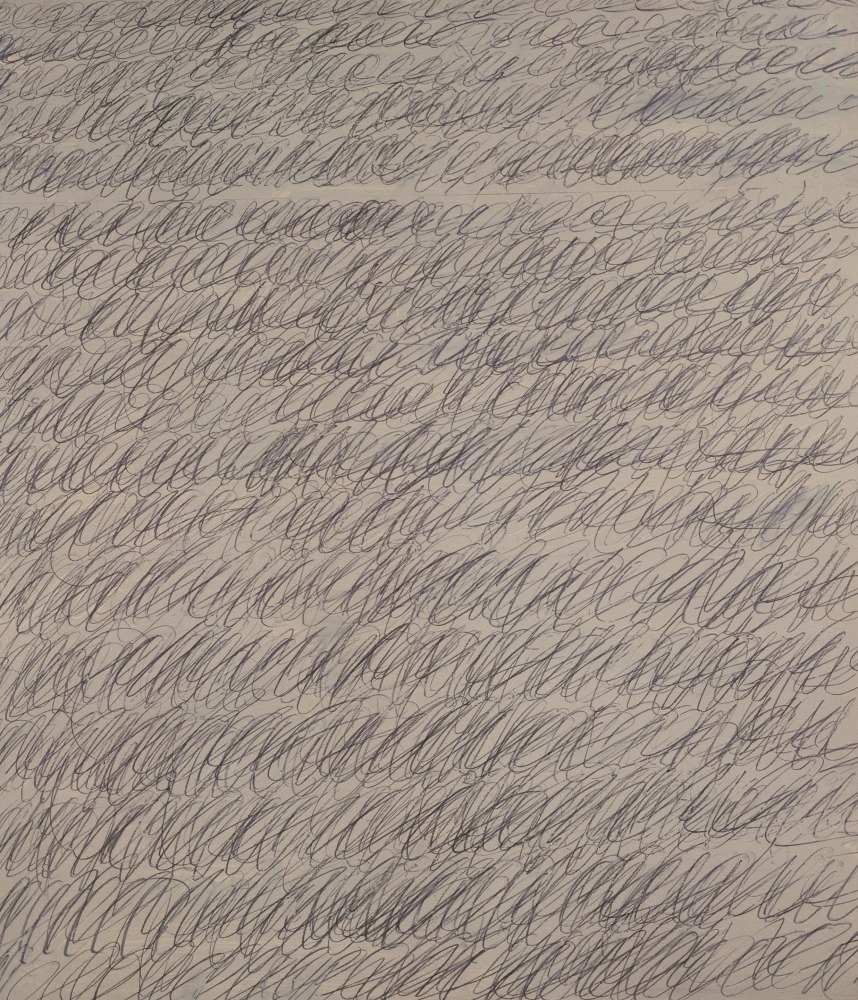
TD: It’s impossible to tell where one mark ends and another begins. The marks are both light and heavy, fast and slow. There’s no tonal variation across the shape—it’s completely even in every direction. To be so controlled over that amount of time and that amount of space is one thing, but to do it seven times is very intense. And while they immediately communicate flatness, they simultaneously lend themselves to a sort of object-ness. You oscillate between seeing a kind of terrestrial Anselm Kiefer landscape to something in the round. They’re hitting that liminal space. When you shift your vantage point, it suddenly looks miles long.
MB: Absolutely.
TD: But that sameness, that kind of under-conscious order, the repetition—in my mind, it conveys a level of concentration that can only come from using everything your body is made of. And I say that looking at people like Julie Mehretu, Cy Twombly, Camille Norris, Eva Hesse, those new Jason Moran works, Agnes Martin—your drawings have an Agnes Martin level of concentration with a Cy Twombly kind of labor of mark-making. I believe that you did that with your body. I looked at these things with a magnifying glass. I literally got on top of them.

Agnes Martin, Drift of Summer, 1965 (detail)
MB: So you really got up close, you saw the real thing.
TD: I had to. I couldn’t believe what I was looking at. I walked in and I was like, “Unh-uh. I need to get in these.” I needed proof that a human being—that’s not Agnes Martin, that’s not working on a grid— has that amount of consistency for that amount of time and that amount of space.
MB: It was some of the hardest work I’ve ever done.
TD: You are also very intentional about your register of politics around abstraction, the history of abstraction, and the way you use that language in terms of your own work, your own identity. Working with your history, your memories, the way in which you lived geographically, and all the choices that you make in your life.
MB: The under-conscious is all about who you really are, it’s in your DNA. I wouldn’t change a day of what happened in my life because that’s the under-conscious. The under-conscious is all about that instinct. It’s as raw as you can go.
READ ON
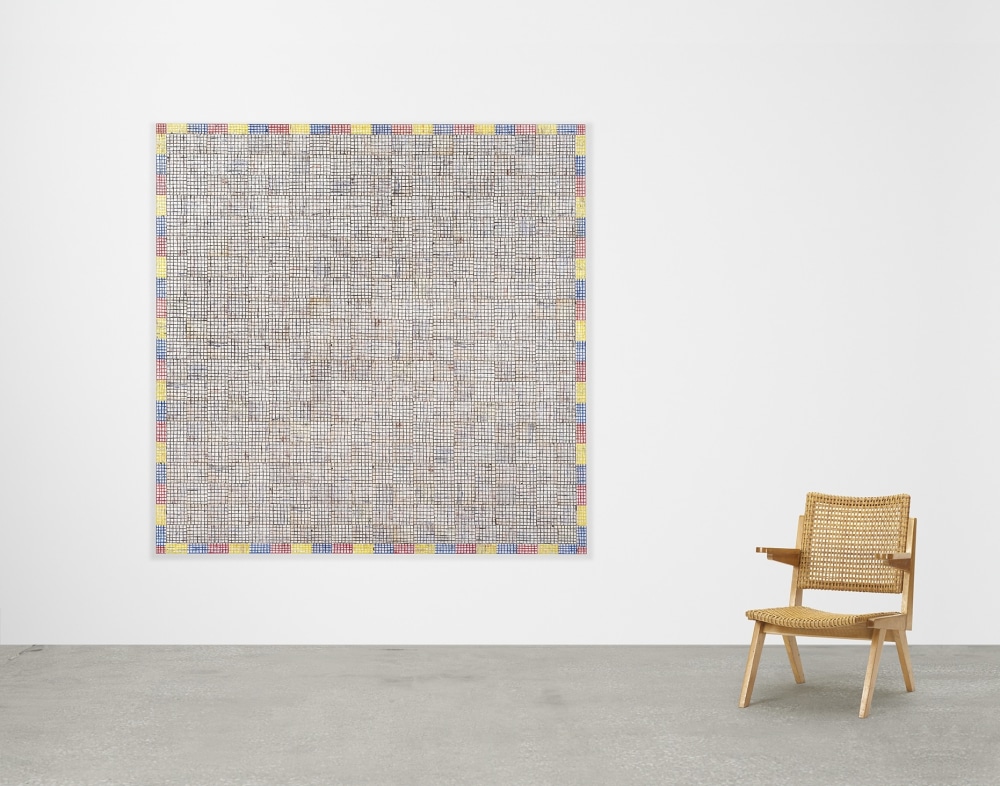
DNA:WORK, 2019
Binion’s DNA:Work paintings appear to be a minimalist abstract grid composed of interlacing and repetitive lines made in oil-stick, yet beneath the surface lies a highly personal narrative. The foundational layer features facsimiles of the artist's address book, which he used while living in New York in the 1970s and 1980s. Addresses and phone numbers for the likes of Jack Whitten, Joanna Pousette-Dart and Stanley Whitney, all written in Binion's scrawl, undergird the work’s form and content. The artist describes the psychological evocations of his address book: "all those names and numbers I've had in one book for over twenty years... working on those I was reliving every day of my life. Every name, every face—it's emotional; you think of things, and you feel things."[iii] Binion's grid pushes back and challenges "attempts to unlink abstraction from questions of location and identity."[iv]
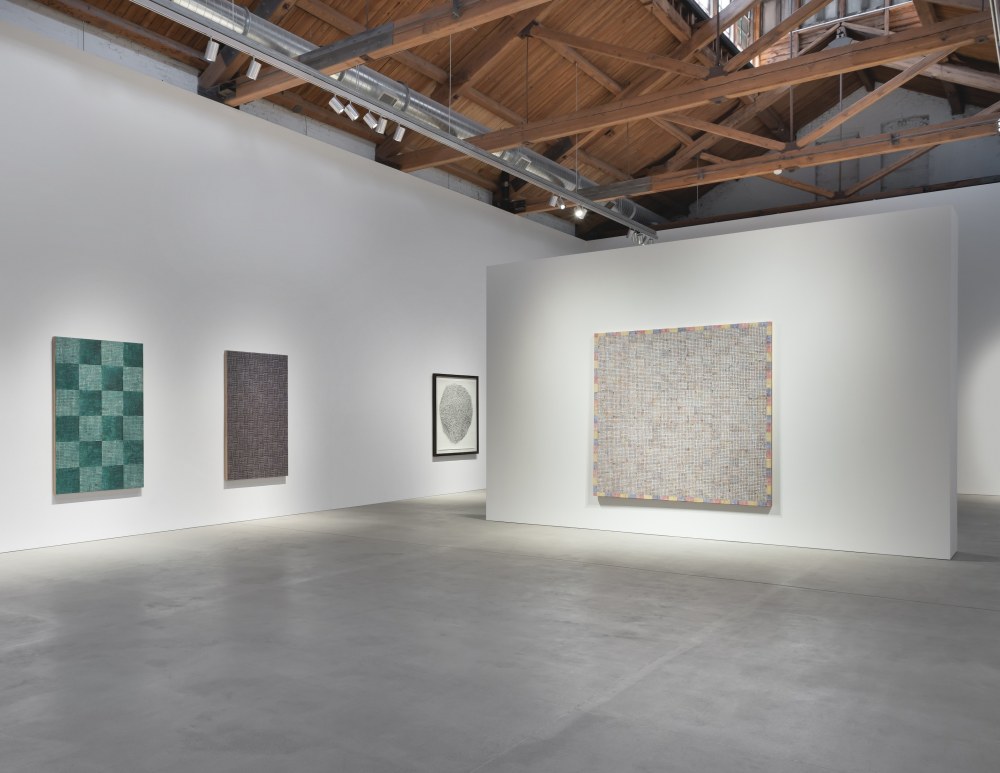
In both its scale and the alternating tiles of the patchwork-like composition, the present painting evokes quilting and textiles, which for years have been salient points of reference for the artist. Here, Binion’s painting practice bridges the visual acuity of 1970s minimalist abstraction and his reverence for the labor and craftsmanship of making. The composition is framed by a repeating band of the primary colors—red, blue, and yellow—calling to mind Mondrian’s prescribed color palette. Like Mondrian’s Broadway Boogie Woogie, the painting also draws inspiration from the syncopated abstraction of music. As Binion says: “I’m interested in the music and the history it came from, not because the art that resulted from it spoke to me. I draw inspiration from jazz musicians like Henry Threadgill, Cecil Taylor, and Lawrence Douglas Butch Morris, and my work operates at the intersection of the introduction of that abstraction.”[v]
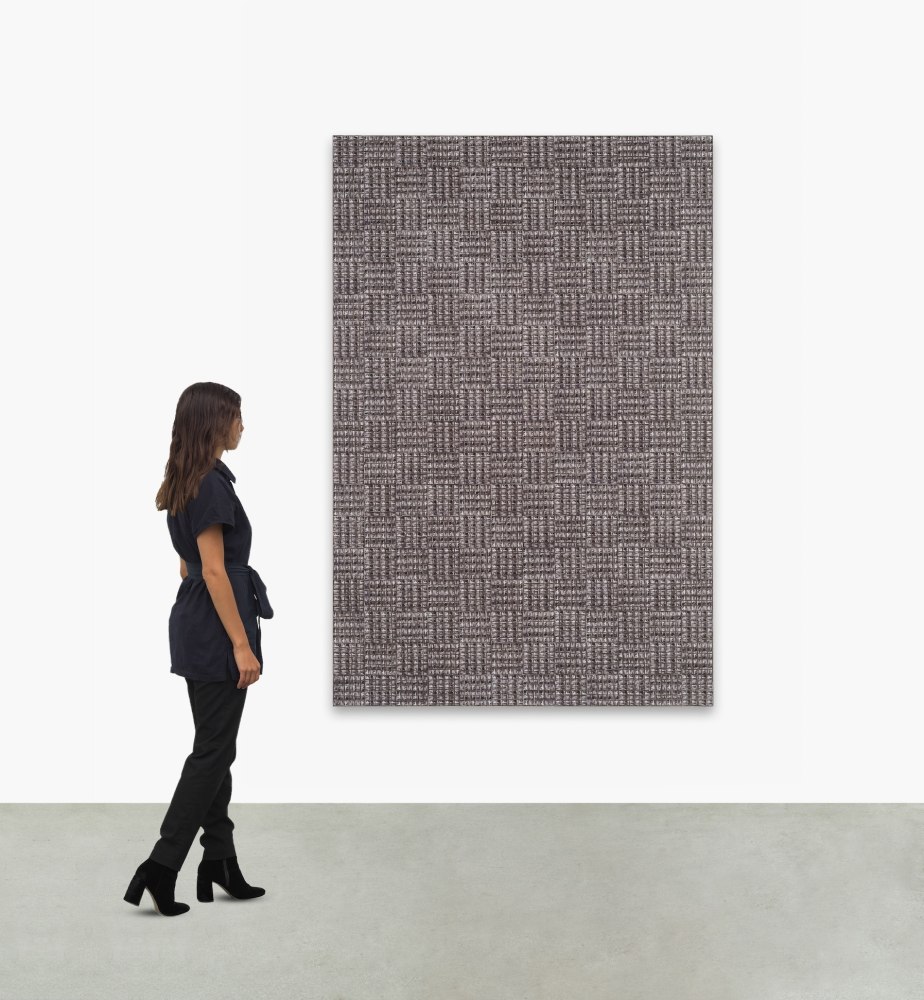
DNA:WORK, 2020
In addition to his address book, McArthur Binion uses other personal photographs and documents to disseminate the intimate details of his identity, relationships and history: the house where he was born (as seen in this painting), his birth certificate, passport photo, and a portrait of his mother are among the other visuals comprising the foundational collage layer in his DNA:Work. Up close, this structured, muted composition reveals tiny images of the two-bedroom farm house in Macon, Mississippi where Binion was born, one of eleven children. The artist credits this circumstance as formative; he relishes the solitude and silence he finds in the studio.
In McArthur Binion’s birth certificate, seen in another DNA:Work painting in the exhibition, one can distinguish the address of this childhood home: “Route One: Box Two,” as well as the explicit designation “colored.” When the artist was four, his family moved from rural Macon, Mississippi to industrial Detroit, Michigan, a biographical detail that speaks to the Great Migration, when 6 million African Americans moved out of the rural Southern United States to the urban Northeast, Midwest, and West.
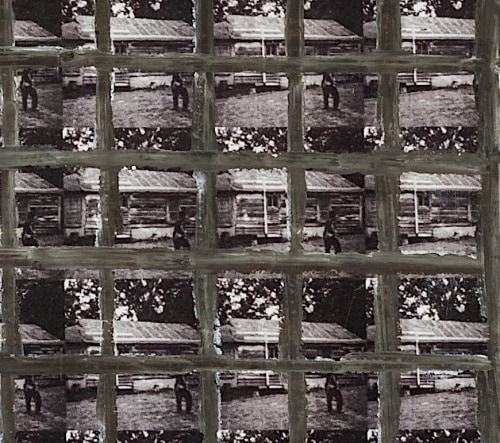
The personal is political, and Binion’s idiosyncratic markers of identity speak to his experience as a Black man in America. In other works, McArthur Binion has more explicitly referenced the segregated South, using images of a lynched man, or, in his Haints series paintings, the shape of Mississippi.
As Yau wrote in a 2015 exhibition review, “In making work in his 'own image,' [Binion] exposes the prejudices, privileges and presumptions inhabiting Frank Stella’s famous dictum, 'What you see is what you see,' and Andy Warhol’s claim, 'Just look at the surface of my paintings, and there I am.' What do these statements mean to a black man growing up under segregation, the struggles of the Civil Rights movement, assassinations of black leaders and sanctioned police brutality? Seen in this context, these observations seem ludicrous and deliberately naïve, if not downright offensive."[vi]

UNDER:CONSCIOUS DRAWING II, 2014
Binion created the seven Under:Conscious Drawings during a period of deep introspection. His experimentation with the medium dates back to his first experiences as an artist: “Drawing is my first love and I didn’t know how far I could go with it—so I started with graphite. Graphite was as far as I thought I could go. Eventually, I started to push it further.” Applying graphite, charcoal, pen, and colored pencil simultaneously with both hands, the artist constructed vast fields of even mark-making, uniting his love for elemental material with his dedication to labor. From a young age, Binion planned to become a poet and began art school as a Creative Writing major. After an impactful encounter with painting at The Museum of Modern Art, he pivoted toward painting and drawing, immersing himself obsessively in artmarking and drawing forty hours a week to progress his craft. As he recalls, “When I started making art, I already had my narrative but had to develop my hand, my tools.”

The gestural Under:Conscious Drawings also speak to the artist’s esteem for labor, which he attributes to his own biography—whether agricultural labor in Mississippi or factory labor in industrial Detroit, physical work played a central role in the artist’s upbringing. This regard for work and craftsmanship manifests in the rigorous build-up of material in his painting and drawing practice. Binion has long embraced using both hands to ensure lack of fatigue.
The physicality of his process is evident in the Under:Conscious Drawings. As Dyson observes, “It looks like [creating these drawings] took everything in you. From your toes to the top of your head.”[vii]
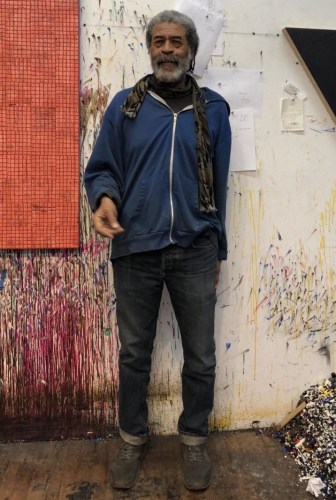
ABOUT MCARTHUR BINION
McArthur Binion (b. 1946 Macon, MS; lives and works in Chicago, IL) creates highly personal and labor-intensive works that assert his unique position between minimalism, identity politics, and abstraction. Binion employs elemental materials such as oil stick, ink, and graphite to create a dense interlacing grid on the surface of his paintings.
This hand-made geometry is applied to a ground layer of neatly tiled images—reproductions of personal photos and documents—that offer glimpses in to the artist’s life: his birth certificate from Mississippi that designates him “colored,” the farm house where he was born, a passport-sized self-portrait, or an address book capturing his formative years in New York among contemporaries Brice Marden, Dan Flavin, and Jack Whitten. Binion’s use of these visuals belie his abstract gridded composition, disseminating intimate details of his personal history, while also staking a firm position within the history of Black Abstraction. Highly influenced by poetry and bebop jazz, McArthur Binion swings between improvisation and order, abstraction and biography. His works refuse easy categorization, continuously shifting between a critique and an acceptance of the minimalist aesthetic, ultimately rooting the works in an individual dedication to the process of painting.
SELECTED EXHIBITIONS & COLLECTIONS
Binion received his BFA from Wayne State University in 1971, and his MFA from the Cranbrook Academy of Art in 1973.
His work has been the subject of major solo and group exhibitions at institutions including the Museo Novecento, Florence, Italy (forthcoming); Museum of the African Diaspora, San Francisco, CA (2019); Institute of Contemporary Art, Boston, MA (2019); Smart Museum of Art, University of Chicago, Chicago, IL (2018); McNay Art Museum, San Antonio, TX (2018); Cranbrook Art Museum, Bloomfield Hills, MI (2018); Mississippi Museum of Art, Jackson, MI (2017); Museum of Contemporary Art San Diego, San Diego, CA (2017); New Orleans Museum of Art, New Orleans, LA (2017); National Museum of African American History and Culture, Washington, DC (2017); Studio Museum in Harlem, New York, NY (2016); Contemporary Arts Museum Houston, Houston, TX (2012).
Binion’s work can be found in numerous public and private collections including the Alfond Collection of Contemporary Art at Rollins College, Cornell Fine Arts Museum, Winter Park, FL; Allen Memorial Art Museum, Oberlin College, Oberlin, OH; Art Bridges Foundation; Cranbrook Art Museum, Bloomfield Hills, MI; Detroit Institute of Arts, Detroit, MI; Institute of Contemporary Art, Boston, MA; Joyner Giuffrida Collection; Kemper Museum of Art, Kansas City, MO; McNay Art Museum, San Antonio, TX; Metropolitan Museum of Art, New York, NY; Mississippi Museum of Art, Jackson, MS; Mott-Warsh Collection, Flint, MI; National Museum of African American History and Culture, Washington, DC; New Orleans Museum of Art, New Orleans, LA; Phillips Collection, Washington, DC; San Francisco Museum of Modern Art, San Francisco, CA; Strauss Family Foundation Collection, Rancho Santa Fe, CA; Studio Museum in Harlem, New York, NY; Toledo Museum of Art, Toledo, OH; Wayne State University, Detroit, MI; and the Whitney Museum of American Art, New York, NY.
i. John Yau, “Recovering Abstraction: McArthur Binion’s Intimate Grids,” Hyperallergic, October 4, 2015.
ii. Binion to Frieze, August, 2020.
iii. Binion, "McArthur Binion on memory and narrative in abstraction," interview by Hiji Nam, Hyperallergic, January 25, 2019.
iv. Ian Bourland, "McArthur Binion," Art in America, March 1, 2019
v. Binion, “Handmade Geometries: McArthur Binion in Conversation with Torkwase Dyson,” interview by Torkwase Dyson, in McArthur Binion: DNA:Work and the Under:Conscious Drawings (Chicago: Gray Chicago/New York, 2020), 23.
vi. Yau, 2015.
vii. Dyson, "Handmade Geometries," 21.